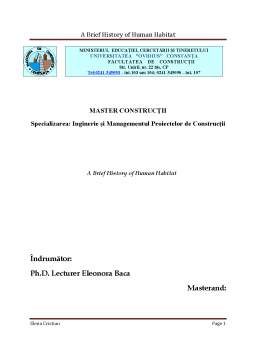Cuprins
- Abstract . 3
- Introduction 3
- Human Habitat . 4
- Human Habitat and Environmental Change . 5
- Conclusion . 6
- References 7
Extras din referat
Abstract
According to traditional image, human habitat constitution is the result of
natural inter-relations, the fundamental premise of the existence of natural resources, the
climate, and the access to more developed proximities for commercial trading. Human
habitat represents a complex system, with environmental values, having live and natural
components that are inter-related. The dwelling is the fundamental component of the
habitat and by relationship with the other components determines the level of habitation.
Ever since the existence of human beings slightly more than two million years ago,
the natural environment has offered numerous settings for human beings to set-up their
homes starting with physical natural shelters in caves to the modern settlements in
megacities.
1. Introduction
Is there a typical human habitat, and if so, what does it look like?
More than likely, there is a distribution of different habitat types that humans occupy at a global, regional, and even local levels, but perhaps there are some common patterns. I realize that the number of people living in the 'urban' environment is increasing rapidly around the world, but even so, what does their habitat look like? Several of us in this lab live in clearly urban environments, but not one is the same. Do a majority live in dense apartment building style environments? Does each person perhaps have (statistially or practically) x trees or x square-meters of lawn or vegetation?
2. Human Habitat
Ever since the existence of human beings slightly more than two million years ago (Leakey & Goodall 1969), the natural environment has offered numerous settings for human beings to set-up their homes starting with physical natural shelters in caves to the modern settlements in megacities.
Human habitat is the environment in which human beings live, work, play and move about. It is not just a dwelling place - a house - but also the sum of all factors that constitute the total environment.
One of the most basic human requirements for survival beside water, food and clothing is shelter. Shelter is required for protection against weather, wild animals and enemy attacks.
Early human dwellings as pointed out by archaeological evidences started in caves. Cave
dwellers date generally from the Stone Age period known as the Paleolithic, which began as early as 2.5 million years ago. Caves are natural shelters, offering shade and protection from wind, rain, and snow.
On every continent, prehistoric foragers made use of caves. In the Zhoukoudian (Chou-k'outien) Cave system near Beijing, China , which dates at 500,000 years, remains of bones and tools of Homo erectus pekinensis (many people, however, still call it Peking Man), have been discovered (UNESCO 2008). Chinese caves contain some of the earliest evidence of human use of fire, approximately 400,000 years ago. In the Shānīdār Cave in Iraq, 50,000-year-old Neandertal skeletons were unearthed in 1957. Ancient pollen buried with them has been interpreted as evidence that these cave dwellers had developed funeral rituals. In the western deserts of North America, caves have been located that contain plant foods, woven sandals, and baskets, representing the desert culture of 9000 years ago. Early inhabitants of Australia, the Middle East, and the Peruvian Andes have also left remains in caves.
Gradually people learned to grow food, rather than forage for it. This was the beginning of the Neolithic age, which, although ending in Western Europe some 4500 years ago, continued elsewhere in the world until modern times. Once agriculture became important, people established villages of permanent houses and found new uses for caves, mainly as hunting and herding campsites and for ceremonial activities. In Europe, Asia, and Africa caves continued to be used as shelters by nomadic groups.
Bibliografie
1. Authorized informative- website, www.unhabitat.org
2. Authorized informative- website, www.habitat.org
3. Authorized informative- website, www.wikipedia.org
3. Raluca Gius, 2008, Trends On Habitat Management, Buletinul Institutului Politehnic Din Iași, Universitatea Tehnică ,,Gheorghe Asachi” din Iași
4. Jamaluddin Md. Jahi, 2009, European Journal of Scientific Research, pp.381-390
6. Blaikie, P. & Brookfield, H., 1987. “Land degradation and society”. London: Methuen & Co.
Preview document
Conținut arhivă zip
- A brief history of human habitat.docx







